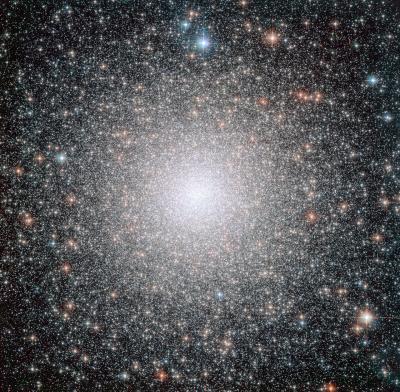Dec 21 2012
Globular clusters are spherical collections of stars, tightly bound to each other by their mutual gravity. Relics of the early years of the Universe, with ages of typically 12-13 billion years (the Big Bang took place 13.7 billion years ago), there are roughly 150 globular clusters in the Milky Way and they contain many of our galaxy's oldest stars.
 This image from the NASA/ESA Hubble Space Telescope shows NGC 6388, a dynamically middle-aged globular cluster in the Milky Way. Credit: NASA, ESA, F. Ferraro (University of Bologna)
This image from the NASA/ESA Hubble Space Telescope shows NGC 6388, a dynamically middle-aged globular cluster in the Milky Way. Credit: NASA, ESA, F. Ferraro (University of Bologna)
But while the stars are old and the clusters formed in the distant past, astronomers using the NASA/ESA Hubble Space Telescope and the MPG/ESO 2.2-metre telescope at the ESO La Silla Observatory have found that some of these clusters are still young at heart. The research is presented in the 20 December 2012 issue of the journal Nature.
"Although these clusters all formed billions of years ago," says Francesco Ferraro (University of Bologna), the leader of the team that made the discovery, "we wondered whether some might be aging faster or slower than others. By studying the distribution of a type of blue star that exists in the clusters, we found that some clusters had indeed evolved much faster over their lifetimes, and we developed a way to measure the rate of aging."
Star clusters form in a short period of time, meaning that all the stars within them tend to have roughly the same age. Because bright, high-mass stars burn up their fuel quite quickly, and globular clusters are very old, there should only be low-mass stars still shining within them.
This, however, turns out not to be the case: in certain circumstances, stars can be given a new burst of life, receiving extra fuel that bulks them up and substantially brightens them. This can happen if one star pulls matter off a neighbour, or if they collide. The re-invigorated stars are called blue stragglers [1], and their high mass and brightness are properties that lie at the heart of this study.
Heavier stars sink towards the centre of a cluster as the cluster ages, in a process similar to sedimentation. Blue stragglers' high masses mean they are strongly affected by this process, while their brightness makes them relatively easy to observe [2].
To better understand cluster aging, the team mapped the location of blue straggler stars in 21 globular clusters, as seen in images from Hubble and the MPG/ESO 2.2-metre telescope at the ESO La Silla Observatory, among other observatories [3]. Hubble provided high resolution imagery of the crowded centres of 20 of the clusters, while the ground-based imagery gave a wider view of their less busy outer regions.
Analysing the observational data, the team found that a few clusters appeared young, with blue straggler stars distributed throughout, while a larger group appeared old, with the blue stragglers clumped in the centre. A third group was in the process of aging, with the stars closest to the core migrating inwards first, then stars ever further out progressively sinking towards the centre.
"Since these clusters all formed at roughly the same time, this reveals big differences in the speed of evolution from cluster to cluster," said Barbara Lanzoni (University of Bologna, Italy), a co-author of the study. "In the case of fast-aging clusters, we think that the sedimentation process can be complete within a few hundred million years, while for the slowest it would take several times the current age of the Universe."
As a cluster's heaviest stars sink towards the centre, the cluster eventually experiences a phenomenon called core collapse, where the centre of the cluster bunches together extremely densely.
The processes leading towards core collapse are quite well understood, and revolve around the number, density and speed of movement of the stars [4]. However, the rate at which they happened was not known until now. This study provides the first empirical way of investigating these different rates of aging.